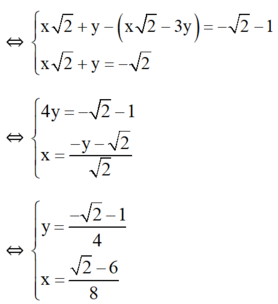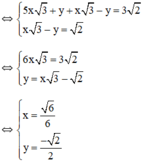Hãy nhập câu hỏi của bạn vào đây, nếu là tài khoản VIP, bạn sẽ được ưu tiên trả lời.

a) Ta có: \(\left\{{}\begin{matrix}\sqrt{2}x-y=3\\x+\sqrt{2}y=\sqrt{2}\end{matrix}\right.\)
\(\Leftrightarrow\left\{{}\begin{matrix}\sqrt{2}x-y=3\\\sqrt{2}x+2y=2\end{matrix}\right.\)
\(\Leftrightarrow\left\{{}\begin{matrix}-3y=1\\x+\sqrt{2}y=\sqrt{2}\end{matrix}\right.\Leftrightarrow\left\{{}\begin{matrix}y=-\dfrac{1}{3}\\x=\sqrt{2}-\sqrt{2}y\end{matrix}\right.\)
\(\Leftrightarrow\left\{{}\begin{matrix}y=-\dfrac{1}{3}\\x=\sqrt{2}-\sqrt{2}\cdot\dfrac{-1}{3}=\dfrac{4\sqrt{2}}{3}\end{matrix}\right.\)
Vậy: Hệ phương trình có nghiệm duy nhất là \(\left\{{}\begin{matrix}x=\dfrac{4\sqrt{2}}{3}\\y=-\dfrac{1}{3}\end{matrix}\right.\)
b) Ta có: \(\left\{{}\begin{matrix}\dfrac{x}{2}-2y=\dfrac{3}{4}\\2x+\dfrac{y}{3}=-\dfrac{1}{3}\end{matrix}\right.\)
\(\Leftrightarrow\left\{{}\begin{matrix}2x-8y=3\\2x+\dfrac{1}{3}y=-\dfrac{1}{3}\end{matrix}\right.\Leftrightarrow\left\{{}\begin{matrix}-\dfrac{25}{3}y=\dfrac{10}{3}\\2x-8y=3\end{matrix}\right.\)
\(\Leftrightarrow\left\{{}\begin{matrix}y=-\dfrac{2}{5}\\2x=3+8y=3+8\cdot\dfrac{-2}{5}=-\dfrac{1}{5}\end{matrix}\right.\)
hay \(\left\{{}\begin{matrix}x=-\dfrac{1}{10}\\y=-\dfrac{2}{5}\end{matrix}\right.\)
Vậy: Hệ phương trình có nghiệm duy nhất là \(\left\{{}\begin{matrix}x=-\dfrac{1}{10}\\y=-\dfrac{2}{5}\end{matrix}\right.\)
c) Ta có: \(\left\{{}\begin{matrix}\dfrac{2x-3y}{4}-\dfrac{x+y-1}{5}=2x-y-1\\\dfrac{x+y-1}{3}+\dfrac{4x-y-2}{4}=\dfrac{2x-y-3}{6}\end{matrix}\right.\)
\(\Leftrightarrow\left\{{}\begin{matrix}\dfrac{5\left(2x-3y\right)}{20}-\dfrac{4\left(x+y-1\right)}{20}=\dfrac{20\left(2x-y-1\right)}{20}\\\dfrac{4\left(x+y-1\right)}{12}+\dfrac{3\left(4x-y-2\right)}{12}=\dfrac{2\left(2x-y-3\right)}{12}\end{matrix}\right.\)
\(\Leftrightarrow\left\{{}\begin{matrix}10x-15y-4x-4y+4=40x-20y-20\\4x+4y-4+12x-3y-6=4x-2y-6\end{matrix}\right.\)
\(\Leftrightarrow\left\{{}\begin{matrix}6x-19y+4-40x+20y+20=0\\16x+y-10-4x+2y+6=0\end{matrix}\right.\)
\(\Leftrightarrow\left\{{}\begin{matrix}-34x+y=-24\\12x+3y=4\end{matrix}\right.\)
\(\Leftrightarrow\left\{{}\begin{matrix}-102x+3y=-72\\12x+3y=4\end{matrix}\right.\Leftrightarrow\left\{{}\begin{matrix}-114x=-76\\12x+3y=4\end{matrix}\right.\)
\(\Leftrightarrow\left\{{}\begin{matrix}x=\dfrac{2}{3}\\12\cdot\dfrac{2}{3}+3y=4\end{matrix}\right.\Leftrightarrow\left\{{}\begin{matrix}x=\dfrac{2}{3}\\3y=4-8=-4\end{matrix}\right.\)
hay \(\left\{{}\begin{matrix}x=\dfrac{2}{3}\\y=-\dfrac{4}{3}\end{matrix}\right.\)
Vậy: Hệ phương trình có nghiệm duy nhất là \(\left\{{}\begin{matrix}x=\dfrac{2}{3}\\y=-\dfrac{4}{3}\end{matrix}\right.\)

 (Chia hai vế pt 2 cho √2 để hệ số của y đối nhau)
(Chia hai vế pt 2 cho √2 để hệ số của y đối nhau)
 (Hệ số của y đối nhau nên cộng từng vế của 2 pt)
(Hệ số của y đối nhau nên cộng từng vế của 2 pt)

Vậy hệ phương trình có nghiệm duy nhất 

Câu a )
\(ĐKXĐx\ne-1,3\)
Ta có :
\(\frac{x}{2x+2}-\frac{2x}{x^2-2x-3}=\frac{x}{6-2x}\)
\(\Rightarrow\frac{x}{2\left(x+1\right)}-\frac{2x}{\left(x+1\right)\left(x-3\right)}=\frac{x}{-2\left(x-3\right)}\)
\(\Rightarrow\frac{x}{2\left(x+1\right)}.2\left(x+1\right)\left(x-3\right)-\frac{2x}{\left(x+1\right)\left(x-3\right)}.2\left(x+1\right)\left(x-3\right)\)
\(=-\frac{x}{2\left(x-3\right)}.2\left(x+1\right)\left(x-3\right)\)
=> x(x-3) -4x =−x(x+1)
=> \(x^2-7x=-x^2-x\)
\(\Rightarrow2x^2-6x=0\)
\(\Rightarrow2x\left(x-3\right)=0\)
\(\Rightarrow x\in\left\{3,0\right\}\)
Câu b )
Ta có :
\(\hept{\begin{cases}\sqrt{2}x-3y=2006\\2x+\sqrt{3}y=2007\end{cases}}\)
\(\Rightarrow\hept{\begin{cases}\sqrt{2}x-3y=2006\\2\sqrt{3}x+3y=2007\sqrt{3}\end{cases}}\)
\(\Rightarrow\hept{\begin{cases}\sqrt{2}x-3y=2006\\2\sqrt{3}x+3y+\sqrt{2}x-3y=2007\sqrt{3}+2006\end{cases}}\)
\(\Rightarrow\hept{\begin{cases}\sqrt{2}x-3y=2006\\\left(\sqrt{2}+2\sqrt{3}\right)x=2007\sqrt{3}+2006\end{cases}}\)
\(\Rightarrow\hept{\begin{cases}y=\frac{\sqrt{2}x-2006}{3}\\x=\frac{2007\sqrt{3}+2006}{\sqrt{2}+2\sqrt{3}}\end{cases}}\)
\(\hept{\begin{cases}y=\frac{\sqrt{2}.\frac{2007\sqrt{3}+2006}{\sqrt{2}+2\sqrt{3}}-2006}{3}\\x=\frac{2007\sqrt{3}+2006}{\sqrt{2}+2\sqrt{3}}\end{cases}}\)
\(\Rightarrow\hept{\begin{cases}y=\frac{2007\sqrt{6}-4012\sqrt{3}}{\left(\sqrt{2}+2\sqrt{3}\right).3}\\x=\frac{2007\sqrt{3}+2006}{\sqrt{2}+2\sqrt{3}}\end{cases}}\)

\(\Leftrightarrow\int^{2x-3\sqrt{2}y=\sqrt{2}}_{2x+y\sqrt{2}=-2}\Leftrightarrow\int^{4\sqrt{2}y=-\sqrt{2}\left(\sqrt{2}+1\right)}_{2x=-2-y\sqrt{2}}\Leftrightarrow\int^{y=-\frac{\sqrt{2}+1}{4}}_{2x=-2+\frac{\sqrt{2}\left(\sqrt{2}+1\right)}{4}}\Leftrightarrow\int^{y=-\frac{\sqrt{2}+1}{4}}_{x=\frac{\sqrt{2}-6}{2}}\)

\(1,3x+2y=7\\ \Leftrightarrow2y=7-3x\left(1\right)\)
Vì \(2y⋮2\)
\(\Leftrightarrow3x-7⋮2\\ \Leftrightarrow3x-9⋮2\\ \Leftrightarrow3\left(x-3\right)⋮2\\ \Leftrightarrow x-3⋮2\\ \Leftrightarrow x.lẻ\)
Đặt \(x=2k+1\left(k\in Z\right)\)
Thay vào (1), ta được :
\(\left(1\right)\Leftrightarrow2y=3\left(2k+1\right)-7\\ \Leftrightarrow2y=6k+3-7\\ \Leftrightarrow2y=6k-4\\ \Leftrightarrow y=3k-2\)
Vậy \(x=2k+1;y=3k-2\left(k\in Z\right)\)
\(2,C_1:\left\{{}\begin{matrix}-2x+y=1\\4x+5y=3\end{matrix}\right.\Leftrightarrow\left\{{}\begin{matrix}-4x+2y=2\\4x+5y=3\end{matrix}\right.\\ \Leftrightarrow\left\{{}\begin{matrix}4x+5y=2\\7y=5\end{matrix}\right.\Leftrightarrow\left\{{}\begin{matrix}x=-\dfrac{1}{7}\\y=\dfrac{5}{7}\end{matrix}\right.\\ C_2:\left\{{}\begin{matrix}-2x+y=1\\4x+5y=3\end{matrix}\right.\Leftrightarrow\left\{{}\begin{matrix}y=1+2x\\4x+5y=3\end{matrix}\right.\Leftrightarrow4x+5+10x=3\\ \Leftrightarrow x=-\dfrac{1}{7}\Leftrightarrow y=1-\dfrac{2}{7}=\dfrac{5}{7}\)

a) Ta có: \(\left\{{}\begin{matrix}-x+2y=3\\3x+y=-1\end{matrix}\right.\)
\(\Leftrightarrow\left\{{}\begin{matrix}-3x+6y=9\\3x+y=-1\end{matrix}\right.\Leftrightarrow\left\{{}\begin{matrix}7y=8\\-x+2y=3\end{matrix}\right.\)
\(\Leftrightarrow\left\{{}\begin{matrix}y=\dfrac{8}{7}\\-x=3-2y=3-2\cdot\dfrac{8}{7}=\dfrac{5}{7}\end{matrix}\right.\)
hay \(\left\{{}\begin{matrix}x=-\dfrac{5}{7}\\y=\dfrac{8}{7}\end{matrix}\right.\)
Vậy: Hệ phương trình có nghiệm duy nhất là \(\left\{{}\begin{matrix}x=-\dfrac{5}{7}\\y=\dfrac{8}{7}\end{matrix}\right.\)
b) Ta có: \(\left\{{}\begin{matrix}2x+2\sqrt{3}\cdot y=1\\\sqrt{3}x+2y=-5\end{matrix}\right.\)
\(\Leftrightarrow\left\{{}\begin{matrix}2\sqrt{3}x+6y=\sqrt{3}\\2\sqrt{3}x+4y=-10\end{matrix}\right.\)
\(\Leftrightarrow\left\{{}\begin{matrix}2y=\sqrt{3}+10\\\sqrt{3}x+2y=-5\end{matrix}\right.\)
\(\Leftrightarrow\left\{{}\begin{matrix}y=\dfrac{\sqrt{3}+10}{2}\\x\sqrt{3}+2\cdot\dfrac{\sqrt{3}+10}{2}=-5\end{matrix}\right.\)
\(\Leftrightarrow\left\{{}\begin{matrix}y=\dfrac{\sqrt{3}+10}{2}\\x\sqrt{3}=-5-\sqrt{3}-10=-15-\sqrt{3}\end{matrix}\right.\)
hay \(\left\{{}\begin{matrix}x=-1-5\sqrt{3}\\y=\dfrac{\sqrt{3}+10}{2}\end{matrix}\right.\)
Vậy: Hệ phương trình có nghiệm duy nhất là \(\left\{{}\begin{matrix}x=-1-5\sqrt{3}\\y=\dfrac{\sqrt{3}+10}{2}\end{matrix}\right.\)

(Các phần giải thích học sinh không phải trình bày).
 (Chia hai vế của pt 2 cho √2 để hệ số của x bằng nhau)
(Chia hai vế của pt 2 cho √2 để hệ số của x bằng nhau)
 (Trừ từng vế của hai phương trình)
(Trừ từng vế của hai phương trình)

Vậy hệ phương trình có nghiệm duy nhất

 (Chia hai vế pt 2 cho √2 để hệ số của y đối nhau)
(Chia hai vế pt 2 cho √2 để hệ số của y đối nhau)
 (Hệ số của y đối nhau nên cộng từng vế của 2 pt)
(Hệ số của y đối nhau nên cộng từng vế của 2 pt)

Vậy hệ phương trình có nghiệm duy nhất 
Kiến thức áp dụng
Giải hệ phương trình bằng phương pháp cộng đại số
1) Nhân hai vế của phương trình với mỗi hệ số thích hợp (nếu cần) sao cho hệ số của một trong hai ẩn bằng nhau hoặc đối nhau.
2) Áp dụng quy tắc cộng đại số để được hệ phương trình mới, trong đó có một phương trình mà hệ số của một trong hai ẩn bằng 0 (tức là phương trình một ẩn).
3) Giải phương trình một ẩn vừa thu được rồi suy ra nghiệm của hệ đã cho và kết luận.

\(\frac{1}{x-3}=a,\frac{1}{y-4}=b\)
\(hpt\Leftrightarrow\hept{\begin{cases}a+b=\frac{5}{3}\\4a-3b=\frac{3}{2}\end{cases}\Rightarrow\hept{\begin{cases}a=\frac{13}{14}\\b=\frac{31}{42}\end{cases}\Rightarrow}}\hept{\begin{cases}x=\frac{53}{13}\\y=\frac{166}{31}\end{cases}}\)

(Các phần giải thích học sinh không phải trình bày).
Vậy hệ phương trình có nghiệm duy nhất